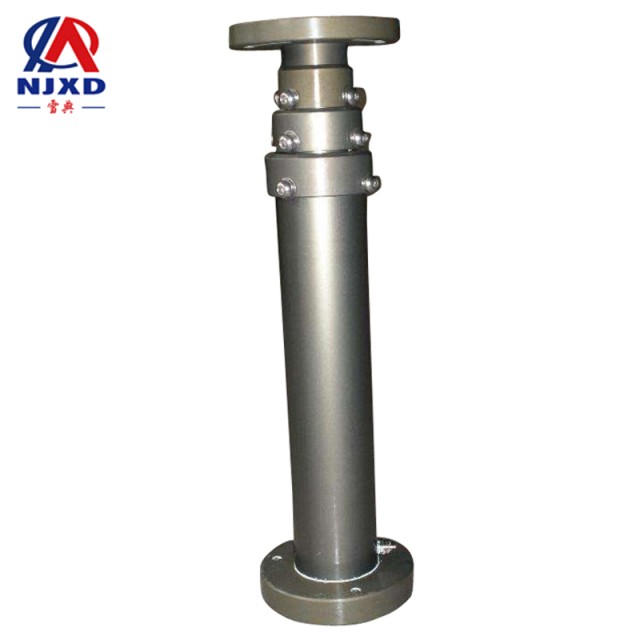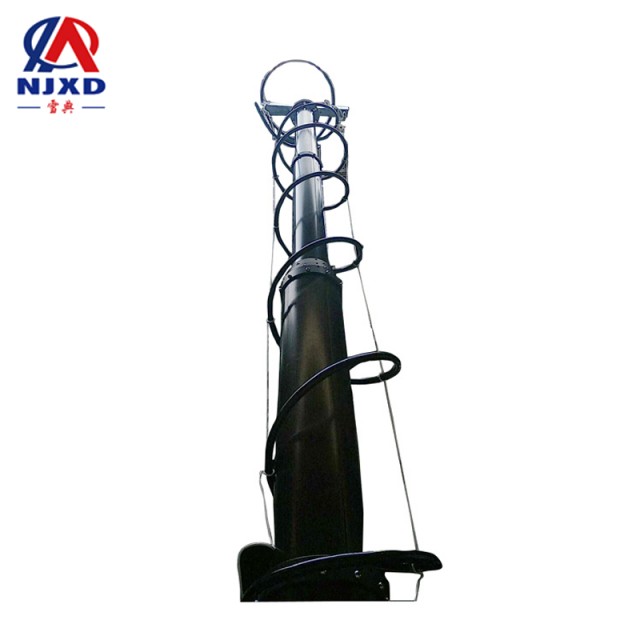NEWS
Common faults and solutions of lift rod cylinder
Time:2021-09-27 View:

Common faults
Problem
The cylinder is cast, and the cylinder must be aged after leaving the factory, so that the internal stress generated during the casting process of the cylinder can be completely eliminated. If the aging time is short, the processed cylinder will be deformed in future operation. It can be used in telescopic mast.
The stress of the cylinder during operation is very complicated, except for the static load such as the pressure difference of the gas inside and outside the cylinder and the weight of each component installed therein, it should also bear the reaction force to the static part when the steam flows out of the static blade, and the force to the cylinder under the cold and hot conditions of various connecting pipelines. Under the interaction of these forces, the cylinder is prone to plastic deformation and leakage.
The load of the cylinder increases and decreases too fast, especially the temperature changes greatly when the startup, shutdown and working conditions change, the way of warming the cylinder is incorrect, and the insulation layer is opened too early during shutdown and overhaul, etc, great thermal stress and thermal deformation are generated in the cylinder and flange.
The cylinder produces stress during mechanical processing or after repair welding, but the cylinder is not tempered to eliminate, resulting in large residual stress in the cylinder, permanent deformation occurs during operation.
In the process of installation or overhaul, due to the inspection process and maintenance technology, the expansion gap of inner cylinder, cylinder partition plate, diaphragm housing ring and steam envelope is inappropriate, or the expansion gap of the hanging ear pressure plate is not suitable, and huge expansion force is generated after operation to deform the cylinder.
The quality of the cylinder sealant used is not good, there are too many impurities or the model is wrong; If there are hard impurity particles in the cylinder sealant, it will be difficult for the sealing surface to combine tightly.
The tightness of cylinder bolts is insufficient or the material of bolts is unqualified. The tightness of cylinder joint surface is mainly realized by the tightening force of bolts. The thermal stress and high temperature generated when the unit starts and stops or increases or decreases the load will cause the stress relaxation of the bolt. If the stress is insufficient, the pre-tightening force of the Bolt will gradually decrease. If the bolt material of the cylinder is not good, the Bolt will be lengthened under the action of thermal stress and cylinder expansion force during long-term operation, resulting in plastic deformation or fracture, and the tightening force will be insufficient, make the cylinder leak.
The cylinder bolt fastening sequence is incorrect. General cylinder bolts are tightened from the middle to both sides at the same time, that is, from the largest vertical arc or the place with the largest stress deformation, in this way, the gap at the place with the largest deformation will be transferred to the free end before and after the cylinder, and finally the gap will gradually disappear. If it is tight from both sides to the middle, the gap will be concentrated in the middle, and the cylinder joint surface will form a bow gap, causing steam leakage.
Cause
Internal and external leakage of cylinder is usually caused by eccentric installation of piston rod, insufficient supply of lubricating oil, abrasion or damage of sealing ring and seal ring, impurities in cylinder and scars on piston rod. Therefore, when internal and external leakage occurs in the cylinder, the center of the piston rod should be readjusted to ensure the coaxiality between the piston rod and the cylinder drum; It is necessary to check whether the work of the atomized Lubricator is reliable, in order to ensure that the actuator is well lubricated; When the sealing ring and seal ring are worn or damaged, it must be replaced in time; If there are impurities in the cylinder, it should be removed in time; When there are scars on the piston rod, should be replaced.
The insufficient output force and unstable movement of the cylinder are generally caused by the piston or piston rod being stuck, poor lubrication, insufficient air supply, or condensed water and impurities in the cylinder. In this regard, the center of the piston rod should be adjusted; Check whether the work of atomized Lubricator is reliable; Whether the gas supply pipeline is blocked. When there is condensate and impurities in the cylinder memory, it should be removed in time.
The poor buffer effect of the cylinder is usually caused by the wear of the buffer seal ring or the damage of the adjusting screw. At this time, the sealing ring and adjusting screw should be replaced.
The damage of the piston rod and cylinder head of the cylinder is usually caused by the eccentric installation of the piston rod or the ineffectiveness of the buffer mechanism. In this regard, the center position of the piston rod should be adjusted; Replace the buffer seal ring or adjusting screw.
Solution
1. For the joint surface with large cylinder deformation or serious steam leakage, the method of grinding and scraping the joint surface is adopted.
If the joint surface of the upper cylinder is deformed within the range of 0.05mm, the joint surface of the above cylinder is the base surface, and the joint surface of the lower cylinder is coated with red pill or embossed with blue paper, and the cylinder is scraped according to traces. If the joint surface of the upper cylinder has a large amount of deformation, apply red pill to the upper cylinder, use balance to grind out traces, and smooth the upper cylinder. Or take the method of mechanical processing to leveling the upper cylinder joint surface, and then the above cylinder as the benchmark to scrape the lower cylinder joint surface. Generally, there are two methods for scraping the cylinder joint surface:
(1) it is a bolt that does not tighten the joint surface. Use a jack to slightly push the upper cylinder forward and backward to move, and grind and scrape according to the coloring condition of the red pill on the joint surface of the lower cylinder. This method is suitable for high-pressure cylinders with strong structural rigidity.
(2) it is the bolt of the tight joint surface. According to the feeler gauge, check the tightness of the joint surface, measure the value and the pressure marks, and repair the joint surface. This method can eliminate the influence of the vertical arc of the cylinder on the gap.
2. Use appropriate cylinder sealing materials
Because there is no unified national standard and industry standard for turbine cylinder sealant, the raw materials and formulas are also different, and the product quality is uneven; When selecting turbine cylinder sealant, it is necessary to select regular manufacturers with reputation and guaranteed product quality in the industry to ensure the tightness of the cylinder after maintenance.
3. Local repair welding method
Since the cylinder joint surface is washed or corroded by steam, use appropriate welding rod to flatten the groove, use flat plate or balance to grind out traces, and scratch the welding channel and joint surface are in the same plane. When the cylinder joint surface is deformed or steam leakage is serious, repair welding one or two 10-20mm wide dense elimination gaps of sealing tape on the joint surface of the lower cylinder, and then use balance or buckle the upper cylinder to measure, and apply red Dan to scrape until the gap is eliminated. The process of this operation is also very simple. Preheat the cylinder to 150℃ before welding, and then conduct back step welding or jump welding at room temperature. Select austenitic electrode, such as A407 and A412, and cover with asbestos cloth after welding to keep warm and cool slowly. After cooling the room temperature, grinding and scraping.
4. Coating or spraying of cylinder joint surface
When the cylinder joint surface has a large area of steam leakage and the gap is about 0.50mm, in order to reduce the workload of scraping, the coating process can be used. The cylinder is used as anode, the coating is used as cathode, and the electrolytic solution is repeatedly applied on the joint surface of the cylinder. The thickness of the coating depends on the size of the gap between the joint surface of the cylinder, the type of coating depends on the cylinder material and the scraping process. Spraying is to use a special high-temperature flame spray gun to heat the metal powder to melt or reach the plastic state and then spray it on the surface of the treated cylinder to form a coating method with the required performance. It is characterized by simple equipment, convenient operation and firm coating. After spraying, the cylinder temperature is only 70℃-80℃, which will not deform the cylinder, and it can obtain heat-resistant, wear-resistant and corrosion-resistant coating. Note that the cylinder surface should be polished, deoiled and brushed before coating and spraying, and the coating should be scraped after coating and spraying to ensure strict bonding surface.
5. Method of combining surface padded
If the local gap leakage of the joint surface is not very large, the hardness of 80-100 mesh copper mesh can be reduced by heat treatment, then cut into appropriate shape and spread on the Steam leakage of the joint surface, then equipped with cylinder sealant. If the gap of the joint surface is large and the leakage is serious, a slot with a width of 50mm and a depth of 5mm can be opened on the upper and lower joint surface, and a toothed pad with a width of IGr18Ni9Ti can be embedded in the middle, the thickness of the toothed pad is generally 0.05-0.08mm larger than the depth of the groove, and can be adjusted with stainless steel gasket of the same shape.
6. Method of controlling bolt stress
If the deformation of the cylinder joint surface is small and uniform, new bolts can be replaced at the gap or the preload of bolts can be plus-sized. Tighten the bolts from the middle to both sides at the same time, that is, tighten the bolts from the place with the largest vertical arc or the place with the largest stress and deformation. Theoretically, the pre-tightening force of the control bolt can be calculated by the formula d/l≤a, but because the calculated data and measurement methods are still under study, they have not reached the promotion, most of them are based on experience within the maximum allowable stress of bolts.
7. Polymer materials adopted in the new period
With the further development of technology, polymer composite materials have gradually been successfully applied in cylinder maintenance. Compared with traditional methods, polymer composite materials have better temperature resistance, good pressure resistance, and better sealing performance, and have good plastic denaturation, and will not cure when heated, sealing Film will not be damaged, thus ensuring the sealing surface of the machine parts; In addition, it is easy to remove, and the used sealing surface can be easily wiped away by anhydrous ethanol or acetone, without attaching to the sealing surface; due to its excellent performance, it is gradually favored by more and more cylinder enterprises.
